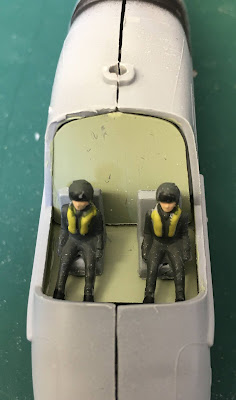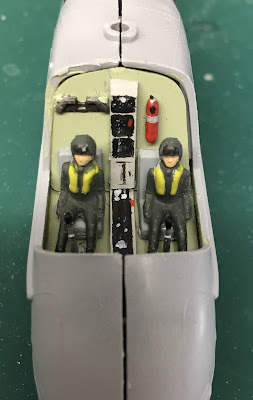This week’s scale model is a little different … 4 weeks ago I set out to build two Falklands War Sea King helicopters, the HC.4 Commando and the HAS.2 Anti-submarine variants. It has been the most absorbing build of my lockdown modelling projects to date. Working on them side by side has both been a real challenge and a journey of discovery. My reason for choosing two, was to build the two distinct Royal Navy Sea King variants which were uniquely used together during the Falklands War. These were the HC.4 Commando and the HAS.2 Anti-submarine.
Both of the base models I used were from Airfix's current range, a rarity in itself as I've more recently had to delve into their discontinued range. Airfix's Westland Sea King HC.4 was a perfect match for the Commando, while their Westland Sea King HAR.3 Starter Set was the closest I could find to the HAS.2 Anti-submarine. While the HAR.3 was actually the RAF's Air Sea Rescue helicopter of the day, the most important feature of this version which I needed for my Anti-submarine helicopter, was its radar dome, however, I later noticed it also had rear observation windows which were not installed on the Anti-submarine! Frustratingly, considering all the other research undertaken, I realised this far too late in the build to to make any adjustments, so I ask you to just ignore them, albeit I find this hard to do myself, as they did cause some further issues which I'll explain later.
As this was such an epic build and I have so much to comment on I'm going to share the story of these helicopters in three instalments. In this post, I'll bring you some of the key features of the early stages in which I was constructing the two models side by side, and then, just as I've done in my previous posts, I'll deep dive into the helicopters' backstories and the more unique parts of each build.
For consistency, I will now reference the HC.4 as just the Commando and the HAS.2 as the Anti-submarine. Hopefully using these names will, at least, be less confusing than their type numbers.
Phase 1 - The Interior
Unwrapping both models and laying the contents out on the desk showed that most of the parts were the same. However, once I started the construction, the variety of parts used, and the number which were not required, was quite surprising. The Commando's interior was just two rows of seats, understandably when considering it was designed to carry up to 27 fully laden troops. Meanwhile, the Anti-submarine, in place of seats, had computer cabinets and a desk with a radar monitor, obviously required to track and sink submarines. An interesting factoid is that once the Argentine submarine threat was neutralised, all this technology was removed to make room for cargo, as the movement of supplies between ships and out to the Islands became an essential role for the helicopter fleet.
 |
| Interior views |
Phase 2 - The Exterior
 |
| Primer added to complement the final colours |
 |
| Final colours added |
Next up was the layer of varnish. I brush painted the matt varnish on the Commando, having previously found this to give a good and smooth enough covering. Applying a gloss coat is normally a different matter and after loading up the spray gun, the fun started! For the first time, Valejo's airbrush compatible paints failed me miserably. Their gloss varnish was too thick, clogging the brush and even when thinned sufficiently to produce a spray it left an orange peel effect on the surface! This is probably just user error but having never had any problems with Humbrol's simple spray cans, this was a real disappointment. Interestingly on the forums, I've read since, most recommend .. and wait for it .. Pledge Floor Gloss over Vallejo's gloss varnish. So, order placed!
 |
| Removing the masking from the glass |
Once varnished, the masking on the glass could be removed, and there was a surprising amount of this! I started masking by cutting tape to fit, which is what I've seen most modellers use, but soon resorted to masking fluid, a new favourite of mine dating back to when I used to do a lot of water colour painting. The fluid can be painted on, so one has to have a steady hand which is not so important with tape, and then it peels off like an Ethan Hunt latex mask; very satisfying!
One thing you'll notice from the above picture is the green glass above the windscreen. This on the full sized helicopter is to protect the crew from the sun streaming in overhead, just like a car's sun visor. I applied this to the underside of the glass pieces using a recent discovery of a mix of Vallejo's clear green, blue and grey paint, mixed to a formula I devised for the Huey's.
Phase 3 - The Decals or Transfers
The Commando needed no additions or changes to those Airfix provided, as I decided early on that I'd go with whatever they had designated for the all over green camouflage version. I did have the option to apply an arctic 'green & white tiger' camouflage, but not being a scheme used in the Falklands War, the decision was easy, my Commando model would be Sea King ZA314 of 848 Naval Air Squadron (NAS).
Decals for the Anti-submarine model was a different matter. With the source Airfix kit being a RAF Air Sea Rescue helicopter, few of the decals could be reused. My aim here was to recreate, as close as possible, one of the Sea Kings my good friend worked on when serving with 824 Squadron. This resulted in me having to acquire 3 additional sets to compliment those generic decals supplied with the model. It's amazing what you can find in the after sales market to model a specific subject. I'll go into more detail on what these decals were when I cover the finishing of the Anti-submarine in one of the next 2 posts, though in the picture below you can get a taster for both with a few of their decals applied.
 |
| First set of decals added |
Phase 4 - The Crew & Figures
For some reason, Airfix seem to be following Italeri's lead these days in providing no figures for their models. Fortunately the Belgium scale model company, PJ Production, make an excellent range of resin figures and coincidentally, if you were paying attention at the start, the most suitable helicopter crew they make are badge air sea rescue!
 |
| Bulk buy of resin helicopter crew |
Apart from the bright orange flying suits, which I did not copy, they were a perfect fit for both Sea Kings. While you'll see them in action in my next posts, I've included a preview shot below of the pilot and co pilot installed, prior to hiding them behind their canopy; always a sad time after all that painstaking detail has been applied!
 |
| Helicopter crew installed prior to hiding them behind the canopy |
The final ancillary figures, important for that final diorama stage of the build, were sourced from Italeri's 1980s NATO Troops and NATO Pilots and Ground Crew sets.
 |
| One of the ground crew modelled on my good friend and conker provided for size! |
 |
| Some of Italeri's NATO Troops dressed up as 3 Para |
So that's about it for now. I hope this has whet your appetite to see more. The Sea Kings are now built and ready for their grand unveiling. All I need to do now is add pictures and backstories to 'paper', which I'll share in my next 2 weekly instalments.
-----------
Brand: Airfix
Title: Westland Sea King HAR.3 Starter set
Number: A55307
Scale: 1:72
Released: 2016 | Rebox (Updated/New parts)
Brand: Italeri
Title: NATO Pilots and Ground Crews ex. ESCI
Number: 1246
Scale: 1:72
Released: 2004 | Rebox
































